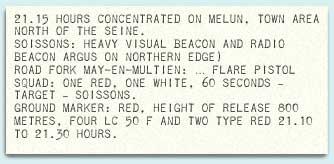
|
On 10 August, OKL was compelled by “further damage to fuel production” to impose “a further, considerably greater reduction of all flying activity.” Bomber operations were to be confined to “decisive actions” and the He 177 units were grounded entirely. The order made it clear that the monthly fuel allocations were the highest possible — there was no point in asking for more. Beyond the immediate effect on operations at the front, the viability of the entire conventional bomber force was now being called into question. A month earlier IX. Fliegerkorps had asked to be allocated 1.5 crews for every aircraft and on 14 August the the General der Kampfflieger, Oberst Walter Marienfeld, agreed that this request was “justified in principle” but it simply could not be met. From D-day to 30 June Luftflotte 3 had lost 175 bomber pilots and in July around 159 (the final figure was not yet available). These casualties and expected aircraft deliveries implied a need for at least 120 new crews each month and their training would require 4,000 tonnes of fuel. The Gen.d.K. had a monthly allocation of 1,500 tonnes and had already grounded Ergänzungsgruppe Ost, dispatching all its Ju 88 crews at an advanced stage of training to its counterpart in the West. Initial training had been cut back to get those crews further along up to operational standard and there were enough pupils for some months. When that supply dwindled it was intended to convert He 111 crews but that would increase the need for fuel. Meanwhile no new men were coming through from the training organisation and there was no guarantee that the flow would resume even though this was “unquestionably necessary.” Without more fuel and an improvement in the supply of crews to the IV. Gruppen there would be more aircraft than crews to fly them, and operations in the West and elsewhere would be curtailed appreciably. By 27 August, Luftflotte 3 was noting that “… fighter and bomber formations have already found themselves unable to participate in operations owing to lack of fuel” while September’s allocation meant cutting back further on operational plans. Even so, a 118-strong raid was flown on the night of the 28/29th with Melun as the target, in particular its bridges and arterial roads. The twin-engined bombers were to go in at 21.15 GMT followed by III./KG 51’s Fw 190s a quarter-hour later. The catastrophic situation on the ground now dictated a wholesale withdrawal of the western bomber force from France and Belgium to bases in the Netherlands and the Reich, the necessary orders going out at 17.00 GMT on the 29th. Strength returns for 29 August and planned destinations were:
continued on next page …
|
||||||||||||||||||||||||||||||||||||||||||||||||||||||||||||||||||||||||||||||||||||||||||||||||||||||||||||||||||||||||||||||||||||||||||||||||||||||||||
 The weather was as forecast, with good visibility; I./KG 66 arrived on time but laid its marker and illuminator flares 3 km. north east of the target while ground navigational aids supposed to have been placed at Meaux and Soissons did not arrive, probably because the first American troops had entered the latter town that evening. As a result, initial bombing was scattered but once ground and air marking had been renewed, accurately this time, later arrivals were able to bomb on target, producing several large fires and explosions with sheets of flame, “possibly an ammunition dump.” Over target and as far as Soissons, 100 km. to the north east, crews encountered moderate well-aimed light and heavy AA. Other observations included ground fighting west of Épernay, fires in Soissons and near Laon, these last interpreted as airfield demolition. One Ju 188 had been lost over German-held territory (possibly through collision with a Mosquito of No. 604 Squadron) and Luftflotte 3’s assessment of the raid was that the majority of crews had been able to find and attack the target and so “a useful effect can be counted on.”
The weather was as forecast, with good visibility; I./KG 66 arrived on time but laid its marker and illuminator flares 3 km. north east of the target while ground navigational aids supposed to have been placed at Meaux and Soissons did not arrive, probably because the first American troops had entered the latter town that evening. As a result, initial bombing was scattered but once ground and air marking had been renewed, accurately this time, later arrivals were able to bomb on target, producing several large fires and explosions with sheets of flame, “possibly an ammunition dump.” Over target and as far as Soissons, 100 km. to the north east, crews encountered moderate well-aimed light and heavy AA. Other observations included ground fighting west of Épernay, fires in Soissons and near Laon, these last interpreted as airfield demolition. One Ju 188 had been lost over German-held territory (possibly through collision with a Mosquito of No. 604 Squadron) and Luftflotte 3’s assessment of the raid was that the majority of crews had been able to find and attack the target and so “a useful effect can be counted on.”